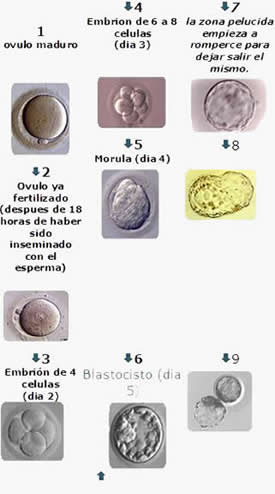BLASTOCYST TRANSFER
A blastocyst is an embryo that has been developing for 5 to 7 days after fertilization. A blastocyst is made up of a blastocoele that is in charge of delivering fluid to the embryo. Trophoblast are cells located in the interior surface of the embryo that in the future will be in charge of forming the placenta.
Internal Cellular mass located in the central part with other various groups of cells will help development of the fetus. When an embryo is cultivated and transferred on day 5, embrionary selection is more adequate since we can select a better quality embryo, keeping less embryos prevent multiple pregnancy therefore having a pregnancy rate a lot higher than those transferred on the 2nd or 3rd day.
A good blastocyst normally will hatch on the 6th day of development, thus, leaving the Pellucid Zone, which is the shield that covers the embryo in its first days. Embryonic Implantation in the uterus of a woman will be done approximately a day after. When we speak of In Vitro Fertilization, we talk about the most innovating method in Assisted Fertilization, and as such we expect that the entire embryo will reach its maximum; that is the birth of a baby. But cultivating the embryo to the state of the blastocyst (day 5) is also a risk, since only 25-60% of human embryos reach this state. This result is more effective when dealing with patients (father and mother) that are in very good physiological conditions, in such cases the embryo can be transferred in day 2 or 3 of the fertilization.
The only problem with transferring on day 2 or 3 is that normally, these types of embryos are located in the Fallopian Tube, lowering the pregnancy rate and increasing the possibility of multiple pregnancies. In contrast, Blastocyst Transference is done in an exact and date and place.
Normal embryo development


